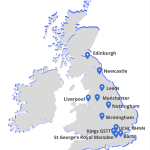National Institute for Health and Care Excellence (NICE) Quality Standards for brain tumours launched last week
Way back in the hot, heady August days (we think there were some) brainstrust invited you to give feedback on 5 draft quality statements designed to improve the standard of diagnosing, monitoring and managing any type of primary brain tumour or brain metastases in people aged 16 or over.
The Standards describe high-quality care in priority areas for improvement. We are so grateful to you for your comments and these influenced the final Quality Standards, published on December 7. We were very privileged to be on the Committee that developed these, as well as being able to harvest opinion from the people for whom these are going to have direct impact – people who are living with a brain tumour.
What are NICE Quality Standards?
Quality Standards set out priority areas for quality improvement in health, public health and social care. They highlight areas with identified variations in current practice. Each standard includes:
- a set of statements to help improve quality
- information on how to measure progress.
For brain and Central Nervous System (CNS) tumours the following Standards have been developed:
- Statement 1. GPs have direct access to standard MRI for adults who have suspected brain tumour.
- Statement 2. Adults with brain tumours have a named healthcare professional who coordinates their health and social care support.
- Statement 3. Adults with radiologically enhancing suspected high-grade gliomas that are suitable for resection of all enhancing tumour have 5‑ALA guided resection.
- Statement 4. Adults who finish treatment for brain tumours have an assessment and discussion about the risk of late effects of treatment at their first follow-up appointment.
- Statement 5. Adults with brain tumours have access to neurological rehabilitation in the community and as an outpatient or inpatient.
What does brainstrust think about these Standards?
These Standards recognise that a step change is needed in these five key areas so that there is parity across the care being delivered to people who are living with a brain tumour. These are the priorities that were identified by the committee and you were invited to give feedback. We think these areas are good areas to prioritise. They aren’t a quick fix, but it does mean that aspects such as having access to prompt scanning, access to a named healthcare professional and access to rehab will now be in the limelight. These are things that are quite simple to expect and that can make a huge difference on quality of life when living with a brain tumour. At the moment we know that sometimes the care offered is different from one region to another, from one hospital to another, from one GP surgery to another. For example, we know that some, but not all of you, are given the name of a healthcare professional whom you can contact. We know too that not all of you have the opportunity to discuss late effects or have access to neurorehabilitation. All of these impact hugely on your ability to be living your best possible life.
We would have liked explicit reference to having a care plan to be included but we didn’t win this one. We’ll be sharing more information about care plans, why they are important and how you can create one in the new year.
Why do they matter?
Quality Standards can be used by anyone who has an interest in improving the health care of people who are living with a brain tumour. This includes commissioners, service providers, practitioners and charities. It could also be patients and those close to them.
They can be referred to by partner organisations who want to follow a consistent approach when defining, measuring and delivering high quality care. Regulators like the Care Quality Commission endorse the use of Quality Standards to help identify and define good quality care.
How will I benefit?
Quality Standards can be used for three things:
- Improving the quality of the care you receive e.g.
- identifying areas for quality improvement
- designing and conducting audits
- writing improvement and action plans
- demonstrating the level at which services should be provided/setting goals
- training and education.
- Monitoring and assuring that the care you receive is of good quality e.g.
- developing frameworks for quality assurance
- identifying gaps in services, benchmarking and monitoring/tracking changes
- setting key performance indicators (KPIs) and monitoring performance
- evidence of service quality for regulators.
- Influencing commissioning
- identifying support or changes needed to improve services
- supporting business cases along with requests for funding and resources.
Whilst they are not mandatory, they do support the government’s vision for a health and care system focused on delivering the best possible health outcomes.
What happens next?
The Quality Standards shine a light on the areas that are most important and where there is potential to drive quality improvement. They do not cover the whole care pathway and the statements must be measurable and specific. It doesn’t work to say everyone must do everything. The more focussed the statement is the more impact it will have.
Quality Standards are reviewed regularly so there will be an opportunity in the future to revise the priority areas if improvements in quality are achieved.
brainstrust will be making sure these Standards stay front of mind so that we can improvement in patient experience and care.









